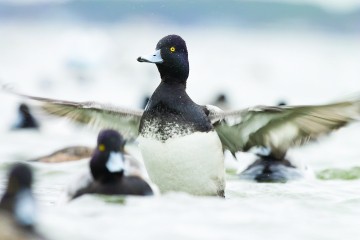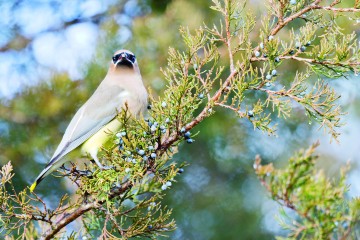Chesapeake Winter
Winter is a wonderful time to study nature in Chesapeake Country. Yes, you read that correctly, the dreaded season of cold and snow. Before I am lambasted for being a warm-weather heretic, let me explain my reasoning.
First, winter in the natural world is mostly a quiet time for humans and nature alike. Similar to our many hardwood species, the crowds of summer now lie dormant, giving you plenty of space to enjoy the natural world.
Second, the lack of foliage makes for ideal conditions for spotting wildlife.
Last, but certainly not least, is the wonderful winter birding that our region offers.
I have always found that one of the most accessible ways to involve oneself in the natural world is birding. On that score, Chesapeake Bay does not disappoint. From comical songbirds to majestic birds of prey, there will be a special bird you can find that will warm your heart even on the coldest of days.
Waterfowl
If you would rather view birds near the water as opposed to woodlands, you are in for a treat. Because of its prime location along the Atlantic flyway, Chesapeake Bay hosts over one million wintering ducks, geese and swans. To put that in perspective, that’s a third of all the wintering waterfowl along the Atlantic coast. These numerous waterfowl species are the Bay’s winter specialty.
Like freshly fallen snow, the snow geese and tundra swans make winter birding magical. Snow geese may be found virtually anywhere during the winter, but huge flocks may be encountered in agriculture fields where they stop to feed. The loud cacophony of their calls as they take off in unison is a rare encounter.
Only a hundred years ago, the snow goose became so rare that hunting of the species was banned. The birds had been plundered for the feather trade. Now they have experienced such a comeback they are one of the world’s most populous goose species.
Our other white winter visitor, the large and eloquent tundra swan, is likely to be seen in the shallow waters of wetlands and tidal rivers, where the big birds feed on a variety of Bay grasses. You may first see their tail feathers before their trademark long neck. When they feed, they submerge their neck into the water, which forces the tail end of their body to tip up out of the water.

Additionally, during the winter months, the Bay and its tributaries are visited by a wide variety of duck species, including the greater and lesser scaup, canvasback, common goldeneye, bufflehead, ruddy duck and the elusive redhead. You may see one or a few at a time, or you may spot thousands at once.
Songbirds
Snow buntings are another winter specialty to be on the lookout for. These adorable songbirds are usually found high in the Arctic, but during the winter months some venture as far south as the Chesapeake Bay. Their nonbreeding plumage (which is how they appear when they may be encountered here) is mostly white intermixed with black and tan feathers. They are ground foragers, feeding in flock formation with the birds in the back flying over the birds in the front, which gives the flock a rolling appearance. I have had most success finding these birds on the sandy beaches of the Chesapeake, including Sandy Point State Park.

Other songbirds more easily encountered on a winter stroll include cedar waxwings, white-crowned sparrows, tufted titmouse, cardinals, both Carolina and winter wren and many others.
My advice is to go where the food is. Many songbirds love to feast on the red berries that adorn the American holly and winterberry tree (both in the wild and the ornamental types found in gardens). While these berries are unsafe for human consumption (and for your beloved pet dog) they are a prized winter food source for birds. You can find American holly and winterberry just about anywhere, from wetlands or on a walk within your neighborhood. Many are along the boardwalk at Battle Creek Cypress Swamp.
Another tree to look for is the eastern red cedar, whose purple-blue berries attract large flocks of cedar waxwing and other birds, including eastern wild turkey. However, looks can be deceiving as these berries are actually small seed cones just like a pinecone.
While the weather outside for some may be frightful, the birding opportunities make it delightful. Our entire state offers a wide range of winter birding opportunities due to its diverse topography. The beauty of birding, though, is you can take part in it from everywhere, from your neighborhood to downtown Annapolis; from the Chesapeake Bay and the surrounding forest. So bundle up, get a pair of binoculars and a regional birding book — and most of all enjoy yourself.
‘Tis the season!
Save
Save
